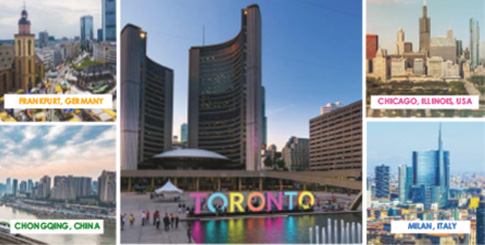Poland’s top industries include manufacturing and agriculture. Agriculture contributes 3 percent to Poland’s GDP and employs over a quarter of the country’s labor force. Home to nearly 2 million farms, Poland is among the world’s top producers of potatoes and apples.
Although Ontario’s manufacturing industry is on the decline, the province, like Poland, is an agricultural powerhouse. The farm sector contributes over $13 billion to Ontario’s annual GDP and supports in excess of 155,000 jobs. The agriculture and agri-food industries combined contribute over 5 percent to Ontario’s GDP.
Similar to Toronto, Warsaw has a humid continental climate with snowy, overcast winters and warm, sunny and stormy summers. Temperatures in the Polish city range between an average of 29°F in January and 66°F in July, closely mimicking its sister city as Toronto’s average temperatures range from 24°F in January to about 72°F in July.
Chicago, Illinois (partnership; 1991)
Toronto officially forged its relationship with Chicago on July 19, 1991. After signing the agreement, Toronto Mayor Art Eggleton remarked the partnership was “the most noteworthy exchange between Chicago and Toronto since George Bell joined the Cubs.”
The third largest city in the United States, Chicago has a population of 9.5 million people throughout its sprawling metropolitan area, known as Chicagoland. A hub of international trade and tourism, the Windy City is home to thousands of renowned restaurants and the Chicago International Produce Market (CIPM), the largest terminal market in the Midwest.
The CIPM has quite a bit in common with its sister city market, the Ontario Food Terminal (OFT). Both terminals are located adjacent to a Great Lake (Chicago on Lake Michigan and Toronto on Lake Ontario), and thanks to lake effect snow, vendors at each of these markets are often faced with harsh winter weather. They are also similar in size: the CIPM at 33 acres with 22 wholesalers, and the OFT at 40 acres with 21 vendors.
Of course, these sister markets aren’t identical twins as there are plenty of differences between the two. First and foremost, the CIPM serves a significantly larger population. Another distinction, according to Scott Weber, vice president of Ruby Robinson Company in Buffalo Grove, IL, is the CIPM “has to contend with unions, while the OFT does not.”
In addition, Weber notes, is that the Chicago market also relies heavily on independent grocers to support the terminal. “Many minority-owned businesses on the CIPM cater to these independents and specific clientele.”
Weber also points out that Chicago has a larger Hispanic population than Toronto, which influences product lines. Indeed, the Chicago-Naperville-Elgin region is ranked as the sixth largest Hispanic population in the United States, with over 2 million Latinos residing in the area.



